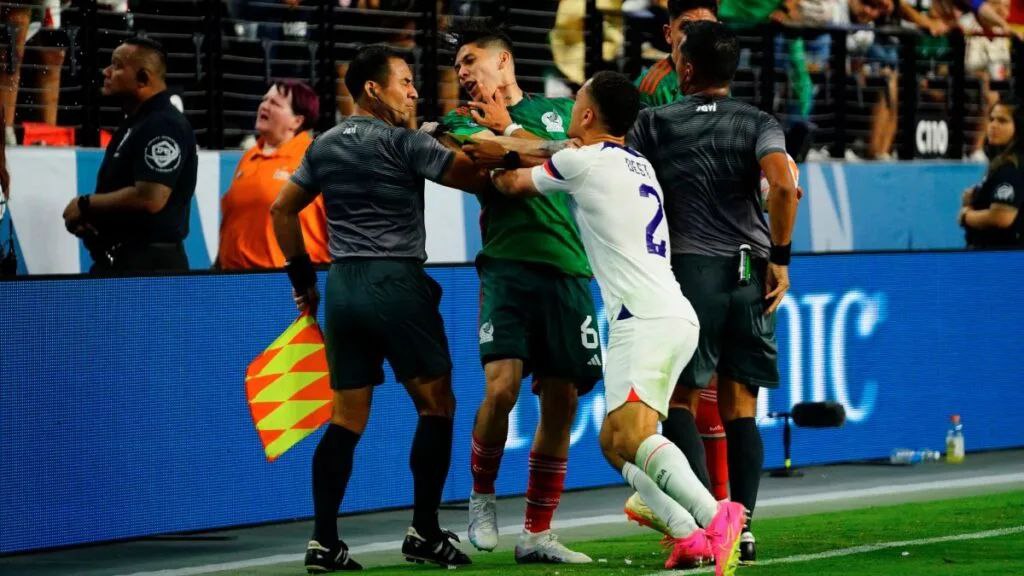Giant of Concacaf? Mexico is far from being one
Giant of Concacaf? Mexico is far from being one.
The football rivalry between Mexico and the United States is one of the most passionate and deeply rooted on the continent.
Beyond sports, this confrontation takes on cultural, political, and social connotations that reflect the complex relationship between both countries throughout history. It seems that when these two teams face each other, each fanbase desperately desires victory as a symbol of revenge.
Americans who increasingly feel ‘invaded’ in their territory, and Mexicans who for a few hours feel at home; with their people, their food, and their songs.

The matchups between Mexico and the United States have been intense and emotional, with games that have left an indelible mark on the memories of fans. In recent times, one of the most remembered is undoubtedly the emblematic final of the Gold Cup in 2011, where Mexico defeated the United States with the famous ‘Fírmala Gio’ [sign it, Gio] moment, narrated by Enrique Bermúdez, which will remain for posterity.
For years, Mexican superiority was evident. In qualifiers, friendlies, and tournaments within the region, Mexico would swell with pride every time they faced the North American team, perhaps being one of the few sports where our country could feel vastly superior.
Unfortunately, the self-proclaimed ‘giant of Concacaf’ no longer exists. In recent years, the matches against the United States, far from being an accessible game for El TRI [the Mexican national team], have become a true nightmare.

In the recount of this already long rivalry, the defeat of Mexico in the 2002 World Cup cannot be forgotten. Without a doubt, it is the most painful in the history of Mexican football. The pursuit of reaching the fifth match [in the World Cup], and when it seemed closer than ever, once again the Mexican national team fell short. Against opponents like Germany or Argentina, the blow is usually less severe, but against the United States, it was simply unforgivable.
Continuing with painful defeats, what can be said about the dominance maintained by the U.S. team in qualifiers, where the “dos a cero” [two to zero] became a chant more than usual among their fans and was even somewhat humiliating for compatriots residing there.
While the overall balance still gives a significant advantage to the Mexican team, it is becoming increasingly difficult to find important victories for ours.
To not go further, we must go back to 2019 to find the last victory of Mexico against the United States. That Gold Cup in Chicago where everything was joy under the command of Tata Martino.
After that, everything collapsed; friendlies, Nations League finals, Gold Cup finals. Including two 3-0 routs.
It hurts to say it, but it is time to forget that famous title of ‘GIANTS’ of the region. What is concerning is that this is not just a simple positive streak for the American team, but rather a very clear mix of good work from the north and poor work in our country, which as a result will not maintain this hegemony, but may even expand it.
How to explain that today there are four times more American footballers in the top European leagues than Mexicans?

In the blink of an eye, there are already 37 North American players in the best football leagues in the world compared to only 8 Mexicans.
We repeat, this will only improve for them, and I dare not say if it is worsening, but I assure you that on this side, we will remain stagnant.
A new Nations League Final Four is about to be contested, and the reality is that the favorite to win it again is the team of the stars and stripes.
The downfall of Tata Martino began against the United States, and Diego Cocca’s brief and battered process ended definitively against the United States.
If they qualify for the final (because first, they would have to defeat Panama), the match against the Americans will represent a before and after for Jimmy Lozano’s management.
Evolution of football compared to Mexican football:
Football in North America has undergone a remarkable evolution in recent decades, with significant growth in both the level of play and sports infrastructure. Both Mexico and the United States have been protagonists of this transformation process, contributing to the development and expansion of football in the region.
In the specific case of Mexican football, we have witnessed an increase in the competitiveness of teams in international tournaments, as well as a rise in the number of Mexican players who have ventured into top foreign leagues. This phenomenon has raised the profile of Mexican football globally and has strengthened the rivalry with the United States in the international context.

On the other hand, football in the United States has experienced exponential growth in terms of popularity and participation. The Major League Soccer (MLS) has gained relevance as one of the most competitive and attractive leagues in the continent, attracting renowned players and contributing to the development of the sport in the country. This growth has generated greater interest among American fans in the rivalry with Mexico, further solidifying this confrontation as one of the most prominent in international football.
In conclusion, the rivalry between Mexico and the United States in football is a phenomenon that goes beyond the playing field. It is an expression of the complex relationship between both countries and reflects the growth and evolution of the sport in the region. With a history rich in emotions and memorable moments, this rivalry continues to be one of the cornerstones of football in North America and a spectacle that captivates millions of fans worldwide.
Bet on the Nations League games, which will undoubtedly be very exciting. Enjoy the thrill of sports and place your prediction for this match at www.mexplay.mx
Double your first deposit up to $5,000 to bet on sports and casino games at mexplay.mx.

Reporter and driver
Cover one of the biggest teams in Mexico;
He was a correspondent in Russia 2018 and Qatar 2022.
One of the new faces in the industry who has found his place thanks to his preparation and adaptation, especially in digital media.


